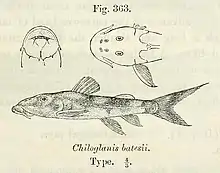Chiloglanis batesii
Chiloglanis batesii is a species of upside-down catfish found widely in Western and Central Africa. This species grows to a length of 4.7 centimetres (1.9 in) TL.[2]
| Chiloglanis batesii | |
|---|---|
 | |
| Scientific classification | |
| Kingdom: | Animalia |
| Phylum: | Chordata |
| Class: | Actinopterygii |
| Order: | Siluriformes |
| Family: | Mochokidae |
| Genus: | Chiloglanis |
| Species: | C. batesii |
| Binomial name | |
| Chiloglanis batesii Boulenger, 1904 | |
Chiloglanis batesii ( fish species)
CLASSIFICATION / Name
Actinopterygii (ray- finned fishes)
Siluriformes (catfish)
Mochokidal (squeakers or upside down cat fishes)
Scientific name: chiloglanis batesii
Common name: Sucker mouth catfish (Rapid catfish).
Environment: Fresh water ; blackish, benthopelagic( deep range). Tropical; 5°N-10°S.
Description:
Dorsal soft rays (tota):56, vertebrae 30-33. This genus is the African equivalent of the sucker mouth catfishes of South America and has a sucking disc that helps them to clinging rocks in fast flowing rivers. It's not an easy genus to identify to species.
Aquarium are good oxygenated water from a power filter sand or gravel substrate with smooth rocks or peddles. This dorsal and pectoral find are Sharp and can cause wounds if not handled carefully.
Sexual difference: usually in the form of a different shaped caudal fin.
Diet/ nutrition: algae, fly larvae food, blood work, flake food.
Distribution. Africa: Cameroon, central Africa republic, Chad, Congo CDM republic, Guinea, Mali, Nigeria.
South Cameroon: Eflulen and stream tributaries of the lobi river, 15-26 miles. Southwest of Eflulen
Temperature: 20-26( 23-26°C) ( 73-79°F).
pH 6.4-7.2
Size: 7.0 cm
Life cycle: distinct pair during breeding ( spawning).
Characteristics.
* It's the second largest fish genus next to synodontis in Africa.
*It's characterized by saws and lips modified into a sucker or oral disc used for adhesiveness and feeding upon objects in the fast flowing waters.
Differences
* It can be distinguished from South America Sucker mouth catfishes by lack of body armour plates.
* The male are distinguished from other male species easily from elongated upper lobe of the caudal fin.
* It has a circular suckermouth disc.
USE: it's used as food to man and other fishes in the water.
References
- Awaïss, A.; Lalèyè, P. & Moelants, T. (2010). "Chiloglanis batesii". The IUCN Red List of Threatened Species. IUCN. 2010: e.T181677A7702750. doi:10.2305/IUCN.UK.2010-3.RLTS.T181677A7702750.en. Retrieved 13 January 2018.
- Froese, Rainer and Pauly, Daniel, eds. (2011). "Chiloglanis batesii" in FishBase. December 2011 version.
